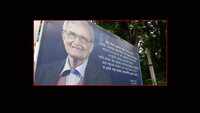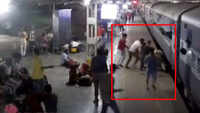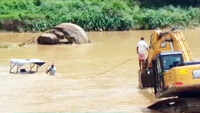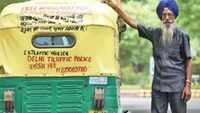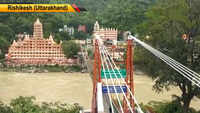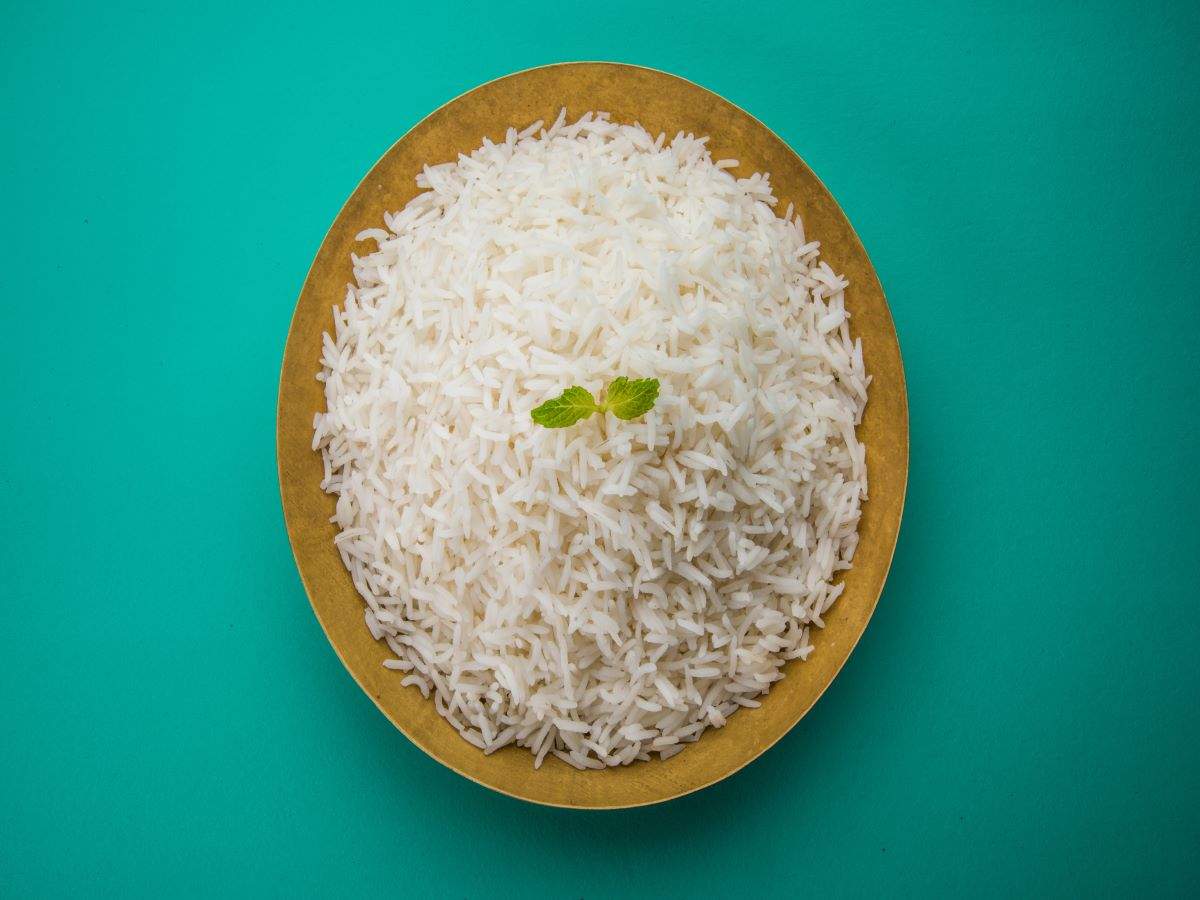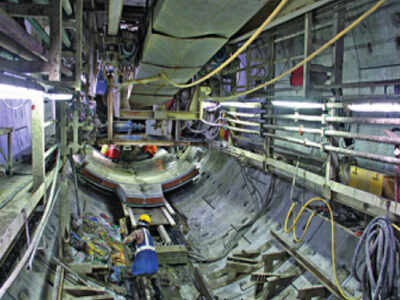
KOLKATA: East-West Metro, recently dubbed a “modern day marvel” by NatGeo, is dashing towards its truncated 5km run through the open spaces of Salt Lake next month. But how does the underground arm of the corridor, under the crammed city centre, where two tunnels are being dug, look?
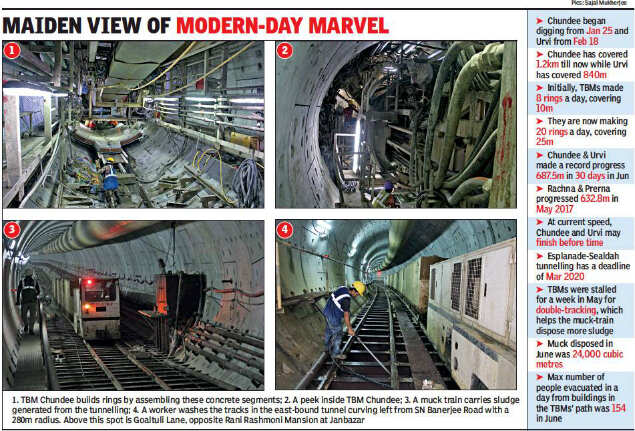
Digging under SN Banerjee Road, one of the tunnels has touched the halfway mark. The twin tunnels are part of the 2.45km Esplanade-Sealdah section that is a continuation of the 3.5km first phase tunnelling from Howrah Maidan to Esplanade. It started in April 2016 and ended in May 2018. Another stretch of East-West Metro, the 5km stretch from Subhas Sarobar to Sealdah is also underground and was completed in 2016.
To get a glimpse of the last leg of construction of the 16km ambitious mesh of Kolkata’s new Metro route, TOI visited Esplanade on a busy Monday morning, descending more than 25m from the shaft to experience the “extreme engineering” happening eight storeys underneath. The roof of the tunnels are around 30m from the ground and it is quite a bit of a walk to reach the 80m-long borers. The tunnel boring machines (TBMs), nicknamed Chundee and Urvi, have been negotiating the highest number of unsafe buildings under one of Kolkata’s oldest streets. This is the most crucial stretch for the project since several wobbly Grade 1 heritage structures and many unlisted mansions dot the route. Some of these 675 edifices along the tunnels’ path on SN Banerjee Road, Nirmal Chandra Street and BB Ganguly Street are over a century old and are on the verge of collapse.
The TBMs have managed to snake through more than 250 crumbling structures in their 40m influence zone and another 60 along their alignment. Chundee, the TBM carving out the west-bound tunnel, is cutting through Nirmal Chandra Street and is set to cross Raja Subodh Mullick Square. The TBM has had to turn sharply off SN Banerjee Road from Janbazar.
Its twin Urvi, building the east-bound tunnel, is around 200m behind. Urvi, too, has left SN Banerjee Road and is now turning left. It will hit Nirmal Chandra Street in another two days. The 280m radius of the bend makes it one of the sharpest in the Metro tunnels and among the most curvaceous in the country. The TBMs have another curve to deal with at the Nirmal Chandra Street-Bowbazar crossing.
For now, the machines are veering at top speed. Between them, the mega borers have achieved a record tunnelling speed of 25m/day on an average, registering minimum ground settlement. When they started in January, the TBMs would build eight to 10 rings a day, barely covering 10m daily. At the current pace, they may complete the 2.45km journey ahead of time.
Kolkata Metro Rail Corporation (KMRC), the implementing agency for the Rs 8,575-crore project, aims to finish the Esplanade-Sealdah tunnelling by March 2020 and commission the entire 16km Howrah Maidan-Sector V corridor by the end of 2021. Since it started rolling in end-January, the first TBM has covered 1.2km, which is half of the 2.45km journey.
Chundee and Urvi were imported from Germany’s Herrenknecht in March 2017 and lowered below the ground at Esplanade in July last year. But the tunnelling couldn’t start as steel joists, left behind from construction of the north-south Metro station, were found in the TBMs’ path. The advanced New Austrian Tunnelling Method (NATM) had to be used to slice off the steel beams since TBMs can bore through almost anything — concrete, mud, slush and water — but not steel.

Digging under SN Banerjee Road, one of the tunnels has touched the halfway mark. The twin tunnels are part of the 2.45km Esplanade-Sealdah section that is a continuation of the 3.5km first phase tunnelling from Howrah Maidan to Esplanade. It started in April 2016 and ended in May 2018. Another stretch of East-West Metro, the 5km stretch from Subhas Sarobar to Sealdah is also underground and was completed in 2016.
To get a glimpse of the last leg of construction of the 16km ambitious mesh of Kolkata’s new Metro route, TOI visited Esplanade on a busy Monday morning, descending more than 25m from the shaft to experience the “extreme engineering” happening eight storeys underneath. The roof of the tunnels are around 30m from the ground and it is quite a bit of a walk to reach the 80m-long borers. The tunnel boring machines (TBMs), nicknamed Chundee and Urvi, have been negotiating the highest number of unsafe buildings under one of Kolkata’s oldest streets. This is the most crucial stretch for the project since several wobbly Grade 1 heritage structures and many unlisted mansions dot the route. Some of these 675 edifices along the tunnels’ path on SN Banerjee Road, Nirmal Chandra Street and BB Ganguly Street are over a century old and are on the verge of collapse.
The TBMs have managed to snake through more than 250 crumbling structures in their 40m influence zone and another 60 along their alignment. Chundee, the TBM carving out the west-bound tunnel, is cutting through Nirmal Chandra Street and is set to cross Raja Subodh Mullick Square. The TBM has had to turn sharply off SN Banerjee Road from Janbazar.
Its twin Urvi, building the east-bound tunnel, is around 200m behind. Urvi, too, has left SN Banerjee Road and is now turning left. It will hit Nirmal Chandra Street in another two days. The 280m radius of the bend makes it one of the sharpest in the Metro tunnels and among the most curvaceous in the country. The TBMs have another curve to deal with at the Nirmal Chandra Street-Bowbazar crossing.
For now, the machines are veering at top speed. Between them, the mega borers have achieved a record tunnelling speed of 25m/day on an average, registering minimum ground settlement. When they started in January, the TBMs would build eight to 10 rings a day, barely covering 10m daily. At the current pace, they may complete the 2.45km journey ahead of time.
Kolkata Metro Rail Corporation (KMRC), the implementing agency for the Rs 8,575-crore project, aims to finish the Esplanade-Sealdah tunnelling by March 2020 and commission the entire 16km Howrah Maidan-Sector V corridor by the end of 2021. Since it started rolling in end-January, the first TBM has covered 1.2km, which is half of the 2.45km journey.
Chundee and Urvi were imported from Germany’s Herrenknecht in March 2017 and lowered below the ground at Esplanade in July last year. But the tunnelling couldn’t start as steel joists, left behind from construction of the north-south Metro station, were found in the TBMs’ path. The advanced New Austrian Tunnelling Method (NATM) had to be used to slice off the steel beams since TBMs can bore through almost anything — concrete, mud, slush and water — but not steel.
World Cup 2019
Trending Topics
LATEST VIDEOS
More from TOI
Navbharat Times
Featured Today in Travel
Quick Links
Lok Sabha Election Schedule 2019Lok Sabha Election NewsDelhi Capitals teamMI team 2019Rajasthan Royals 2019RCB team 2019Maharashtra Lok Sabha ConstituenciesBJP Candidate ListBJP List 2019 TamilnaduShiv Sena List 2019AP BJP List 2019Mamata BanerjeeBJP List 2019 MaharashtraPriyanka GandhiBJP List 2019 KarnatakaAMMK Candidate List 2019BJP List 2019 WBLok Sabha Elections in Tamil NaduBSP List 2019 UPNews in TamilLok Sabha Poll 2019Satta Matka 2018PM ModiMahagathbandhanNagpur BJP Candidate ListChandrababu NaiduTamil Nadu ElectionsUrmila MatondkarNews in TeluguMadras High CourtTejashwi YadavArvind KejriwalTejasvi SuryaPawan KalyanArvind KejriwalYogi AdityanathJaya PradaSatta King 2019Srinagar encounter
Get the app

